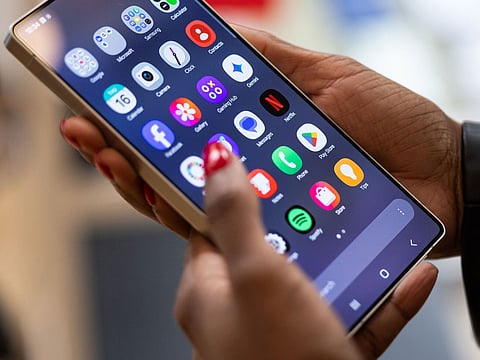New Galaxy S25 gives Samsung a boost, shares jump amid tariff jitters
Demand for servers using the company’s high-density DRAM also bolsters profit

Samsung Electronics Co. handily beat expectations on Galaxy S25 smartphone and legacy DRAM sales, sending easing concerns about the company’s ability to weather both US tariffs and chip export curbs.
Samsung shares went shares up on Tuesday trading.
South Korea’s largest company was helped by inventory stockpiling by Chinese retailers and manufacturers who hurried to secure electronic supplies in the March quarter before US President Donald Trump unleashed tariffs against trading partners.
Demand for servers using the company’s high-density DRAM also bolstered profit, although the outlook for both smartphones and AI components has become murkier over the last week.
Samsung’s stock price rose 4% Tuesday morning in Seoul. Shares of rival SK Hynix Inc. also rose 5%.
Preliminary operating profit came to around 6.6 trillion won ($4.5 billion), level with last year’s performance and beating analysts’ average projection for 5.74 trillion won.
Focus on chips
Revenue climbed roughly 10 per cent to 79 trillion won. The company will provide a full financial statement with net income and divisional breakdowns later this month.
Focus is now shifting to Samsung’s ability to secure higher prices on its chips in coming months, CLSA Securities Korea’s Sanjeev Rana told Bloomberg Television. “This is a good set up for price negotiations with major customers in 2Q and for the rest of the year,” he said.
The boost from the smartphones business is a relief for a company grappling with challenges throughout the pivotal high-bandwidth memory business. The world’s largest memory maker has struggled to get Nvidia Corp.’s final nod for its most advanced HBM, slipping further behind SK Hynix in the lucrative market of chips enabling AI accelerators.
Samsung, which has been aggressively trying to catch up to SK Hynix for 18 months, has been unable to supply meaningful volumes of HBM chips to Nvidia. Losses also continue to mount in its contract chipmaking arm.
That’s left the Korean company more reliant on customers in China who seek products not subject to US export curbs. But that pie is in danger of shrinking as the US tightens restrictions on semiconductor shipments to China.
Samsung had previously said it expects strong AI and mobile demand to boost sales of memory for an earnings recovery in the second half of the year.
Jun Young-hyun, head of the chip business, told shareholders last month that Samsung plans to supply enhanced 12-layer HBM3E as early as the second quarter of this year and aims to get Nvidia’s approval for its cutting-edge HBM4 chips for shipments to start in the second half.
HBM4 memory is expected to be integrated into Nvidia’s upcoming Rubin GPU architecture. To get Nvidia’s signoff, however, Samsung has had to take a step back and first redesign its HBM3E chip, at the risk of falling further behind SK Hynix on the bleeding edge.
SK Hynix is aggressively positioning itself as the primary supplier of HBM4 that’s paired with Nvidia’s advanced graphics processors. The Korean company said it shipped the world’s first 12-layer HBM4 samples to major customers ahead of schedule.
The bright numbers from Samsung’s smartphones business are expected to take a direct hit from Trump’s tariffs, however. Many of the company’s mobile phones are made in Vietnam, while a portion of its home appliances, including TVs, are produced in Mexico, which largely avoided Trump’s broad tariffs.
While Samsung is expected to diversify production to countries such as Brazil to lower the impact, “these things take time,” Rana said. He added, however, that Apple Inc. produces most of its smartphones in China and is struggling with the same issues, leaving open the possibility that Samsung may gain market share from its US rival.
The Suwon-based company was dealt an additional blow from the sudden death of co-CEO Han Jong-hee last month from cardiac arrest. Samsung said last week TM Roh, the head of its mobile business, will temporarily expand his role to also oversee the consumer electronics divisions.
Samsung launched new Galaxy S25 smartphones in San Jose, California in January: the S25 starting at $799, a larger S25+ and the top-tier S25 Ultra priced from $1,299 and up. Spanning 6.9 inches in size, the new Ultra model gains the most significant design changes and camera hardware upgrades.
Sign up for the Daily Briefing
Get the latest news and updates straight to your inbox



